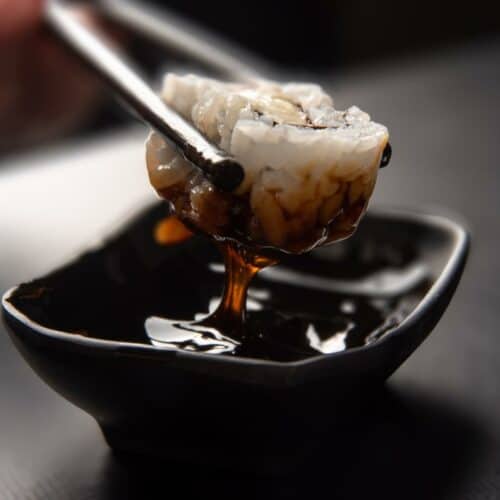Dashi Tare: What Is It And Are Dashi And Tare The Same?
You may have come across dashi tare and wondered what it was.
Dashi tare is a tare sauce made with dashi. Tare sauce is a Japanese dipping sauce and not all are made with dashi, so the distinction is made when it is. Dashi is a broth made from katsuobushi and kombu that gives umami to the sauce.
Let’s look at the differences, how to make and how to use it.

Check out our new cookbook
Bitemybun's family recipes with complete meal planner and recipe guide.
Try it out for free with Kindle Unlimited:
Read for freeIn this post we'll cover:
How to make dashi tare at home

Dashi Tare Sauce Recipe
Ingredients
- ½ cup dashi
- ¼ cup mirin
- ½ cup soy sauce
- 2 tbsp sake
- 1 tsp brown sugar
- 1 tsp rice wine vinegar
- 1 inch piece ginger peeled and smashed
- 1 clove garlic peeled and smashed
- 1 scallion chopped
Instructions
- Combine ingredients in a saucepan and bring to a simmer.
- Simmer tare until it reduces to ½ cup, about 25 minutes.
- Strain solids and let the sauce cool. Store in an airtight container in the refrigerator for up to 2 weeks.
Dashi vs tare
Dashi is a soup stock, and tare is a sauce. Both can be used to flavor soups and other dishes, but tare is also used as a condiment, and dashi is not. Dashi boils kombu and katsuobushi to get a clear broth, while tare is made by simmering soy sauce, mirin, and sake, making a dark brown sauce.
What is dashi?
Dashi is a type of soup stock made from kombu (seaweed) and bonito (a type of fish made into katusobushi). It’s an important ingredient in Japanese cuisine, and its umami flavor is essential to many dishes.
Dashi is made by boiling water and then adding kelp or bonito flakes. The bonito flakes are then removed, leaving a flavorful broth.
What is tare?
Tare is a type of sauce made from soy sauce, mirin, and sugar. It’s often used as a marinade or dipping sauce for meats and vegetables.
Tare is made by simmering soy sauce, mirin, and sugar until the sugar has dissolved. The sauce will be a dark brown color when it’s done.
It’s often used in yakitori restaurants to give the chicken skewers a nice glaze.
There are many types of Japanese glazes and dipping sauces used for a variety of purposes, but tare is one of the most fundamental.
It is used as both a glaze and a dipping sauce and can be found in a great many Japanese dishes.
The word “tare” comes from the Japanese word for “drip.” This is likely because the sauce is often used as a glaze and allowed to drip down the food.
The word can also be written as “taire” or “ta-re.” It is pronounced “the-ray.”
Tare sauce is a key ingredient in yakitori, a popular Japanese dish consisting of skewers of chicken that are grilled over a charcoal fire.
The chicken is marinated in tare sauce before being skewered and cooked. The skewers are then dipped in tare sauce before being served.
Tare looks similar to shoyu (soy sauce) and teriyaki sauce, so it’s often mistaken for one of the two. However, the tare sauce recipe is unique because it uses
What is tare sauce made of?
Tare is made from a variety of ingredients, but the most common are:
- soy sauce
- mirin
- sake
- brown sugar
- salt
All the ingredients are combined and cooked until the desired consistency is achieved. The resulting sauce can be used immediately or stored for later use.
Tare is often made without dashi, but it can have dashi in it to give it more umami. Tare and dashi are also often used together, like in ramen soup, essentially making dashi tare by mixing them within the soup.
Conclusion
Although not the same, both can be used together or separately to flavor Japanese dishes.
Also read: this is how to make a traditional tare dipping sauce
Check out our new cookbook
Bitemybun's family recipes with complete meal planner and recipe guide.
Try it out for free with Kindle Unlimited:
Read for freeJoost Nusselder, the founder of Bite My Bun is a content marketer, dad and loves trying out new food with Japanese food at the heart of his passion, and together with his team he's been creating in-depth blog articles since 2016 to help loyal readers with recipes and cooking tips.
